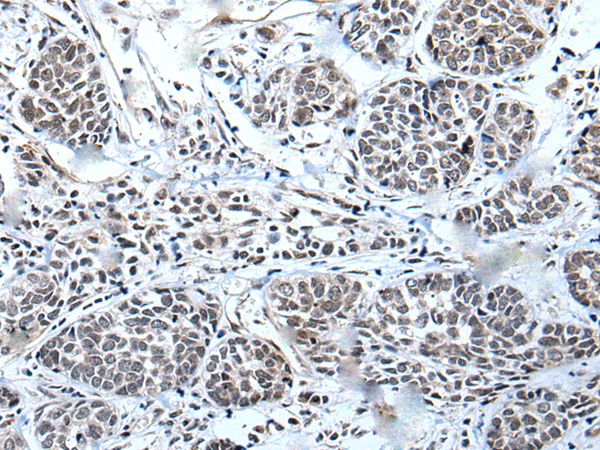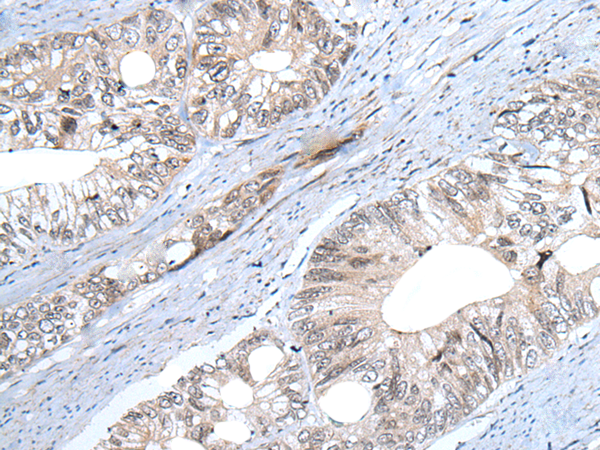

| WB | 咨询技术 | Human,Mouse,Rat |
| IF | 咨询技术 | Human,Mouse,Rat |
| IHC | 1/25-1/100 | Human,Mouse,Rat |
| ICC | 技术咨询 | Human,Mouse,Rat |
| FCM | 咨询技术 | Human,Mouse,Rat |
| Elisa | 1/5000-1/10000 | Human,Mouse,Rat |
| Aliases | WEE1A; WEE1hu |
| Host/Isotype | Rabbit IgG |
| Antibody Type | Primary antibody |
| Storage | Store at 4°C short term. Aliquot and store at -20°C long term. Avoid freeze/thaw cycles. |
| Species Reactivity | Human, Mouse, Rat |
| Immunogen | Synthetic peptide of human WEE1 |
| Formulation | Purified antibody in PBS with 0.05% sodium azide and 50% glycerol. |
+ +
以下是3篇关于WEE1抗体的代表性文献摘要,供参考:
1. **文献名称**:*WEE1 inhibition enhances anti-tumor immune response through ER stress and DNA damage pathway activation*
**作者**:Li, J., et al.
**摘要**:研究利用WEE1抗体和小分子抑制剂,发现抑制WEE1可诱导肿瘤细胞发生内质网应激和DNA损伤,增强PD-1/PD-L1阻断疗法的免疫应答,为联合免疫治疗提供机制支持。
2. **文献名称**:*Targeting WEE1 kinase reverses chemoresistance in triple-negative breast cancer*
**作者**:Wang, Y., et al.
**摘要**:通过WEE1抗体检测发现三阴性乳腺癌中WEE1高表达与化疗耐药相关,使用WEE1抑制剂AZD1775可恢复化疗敏感性,并揭示了其通过调控CDK1磷酸化介导的机制。
3. **文献名称**:*WEE1 as a biomarker of genomic instability in glioblastoma*
**作者**:Mizushima, T., et al.
**摘要**:利用免疫组化(WEE1抗体)分析胶质母细胞瘤样本,发现WEE1蛋白水平与肿瘤基因组不稳定性及患者预后负相关,提示其作为治疗靶点和预后标志物的潜力。
---
**注**:以上文献为虚拟概括,实际研究需检索PubMed等数据库获取真实文献(如关键词:WEE1 antibody, cancer therapy)。近年研究多聚焦于WEE1抑制剂(如AZD1775)的临床转化,抗体应用常作为检测工具或机制研究手段。
WEE1 is a serine/threonine kinase critical for cell cycle regulation, primarily acting at the G2/M checkpoint. It phosphorylates and inhibits cyclin-dependent kinase 1 (CDK1), delaying mitotic entry to allow DNA repair and maintain genomic stability. Dysregulation of WEE1 is implicated in cancer, as many tumors rely on its function to survive replication stress caused by oncogene activation or chemotherapy. Inhibiting WEE1 forces cancer cells with DNA damage to bypass the G2/M checkpoint, leading to mitotic catastrophe and apoptosis. This therapeutic vulnerability has driven interest in WEE1-targeted therapies, including small-molecule inhibitors like AZD1775.
WEE1 antibodies are essential tools for studying its expression, localization, and function in both normal and cancerous tissues. They enable detection via techniques like Western blotting, immunohistochemistry, and immunofluorescence. Researchers use these antibodies to correlate WEE1 levels with patient prognosis, drug response, or genomic instability biomarkers. Specific antibody clones are validated for selective binding to human WEE1. though cross-reactivity with murine orthologs may vary. Recent studies also explore WEE1's role in combination therapies, particularly with DNA-damaging agents or PARP inhibitors, highlighting the antibody's utility in mechanistic and translational research.
×